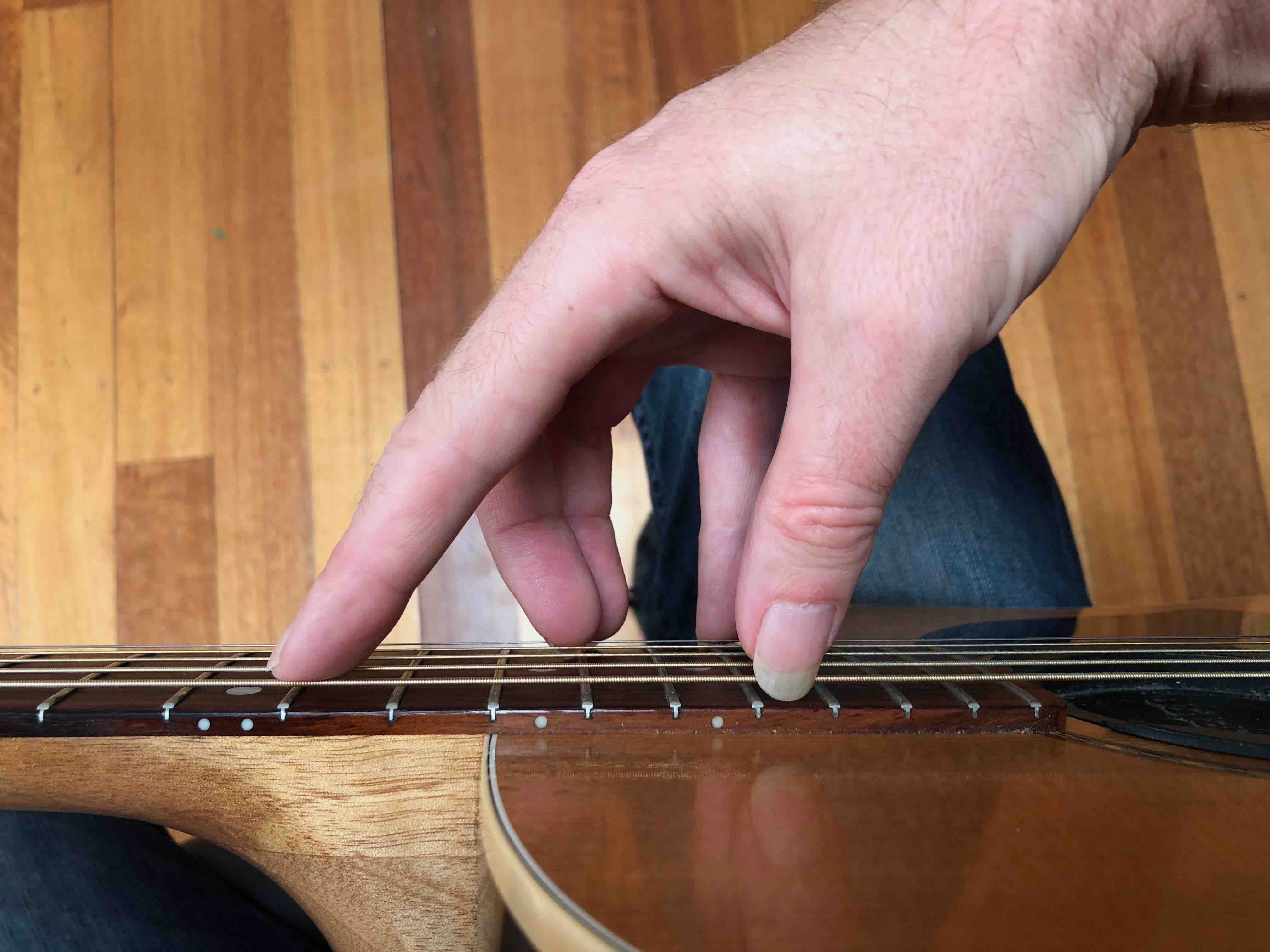How To Become A More Creative Acoustic Guitar Player - Part 1
by Simon Candy
 Feeling bored and stale with your own guitar playing is very common and something that everybody who has played for at least a few years has felt before.
Feeling bored and stale with your own guitar playing is very common and something that everybody who has played for at least a few years has felt before.
You know the feeling, you pick up the guitar and find yourself playing the same old tunes in the same old way.
It can be frustrating, but there's no need to despair. There are plenty of techniques, tools, and resources available to help you break out of your rut and refresh your acoustic guitar playing. With a little effort and some exploration, you can find new ways to challenge yourself and keep your guitar skills fresh and exciting.
In this article, I will share two creative ways to play your acoustic guitar and reignite your inspiration. In part 2, you learn 3 more unique ways you can approach your acoustic guitar playing
How To Reignite Your Guitar Playing Creativity
There have been times over the years of playing guitar that I have felt uninspired and unmotivated with my playing. I would feel very stale and like I was treading water rather than making progress. However, what I found was that being open to other styles of guitar and studying players I had not really heard before really reignited my creativity on the guitar.
There are many elements and techniques from other styles that you can bring into your own playing that will complement what you can already do and literally set your guitar creativity on fire! The following ideas and approaches are just to get you started. I want to make you aware of them, if you are not already, and also encourage you to follow through and explore the ones you like further.
So, let's get to it!
Harmonics
 There is nothing quite like the sound of harmonics in your acoustic guitar playing. In a nutshell, a harmonic is sounded by lightly touching a vibrating string at specific points along its length.
There is nothing quite like the sound of harmonics in your acoustic guitar playing. In a nutshell, a harmonic is sounded by lightly touching a vibrating string at specific points along its length.
Let's look at the octave harmonic. To get this you simply touch the string as it is vibrating, with your picking hand, exactly 12 frets higher from where you sounded the note. You must touch the string directly over the fret itself, not in between as you would normally do.
Check the picture for reference.
As you can see, I am using my index finger to touch the string while my thumb plucks the string itself from behind sounding a "bell" like harmonic.
In the example below I am sounding open string harmonics. Remember that you need to play exactly 12 frets higher from the note itself. So open string + 12 frets = 12th fret:

* In the example above, the p indicates your thumb and the i indicates your index finger both of which are used to sound the harmonic. The note in the bracket indicates the fret that your index finger is above at the time. In this case, it is the 12th fret all the way
This sounds great over an Em chord or the key of Em in general. However, you don't need to stop there. You can sound harmonics from any fretted note you like. Just be sure to place your index finger exactly 12 frets higher from where you are sounding your note.
Here is an example:

Above, I am using harmonics to produce a G major scale.
To achieve this, you must ensure that your index finger is precisely placed 12 frets above the note being sounded, as indicated in the brackets. It is essential to mentally visualize the shape of the scale one octave higher while sounding the harmonics, and simultaneously play it one octave lower with your fretting hand.
How To Start Creating With Harmonics On Your Acoustic Guitar Right Now
• Take the G scale from above right now and sound it with harmonics over a backing track in the same key. Mix the notes/harmonics up and you will be creating a really cool and unique sound on your acoustic guitar instantly.
• Take an existing melody you know in G Major and sound it out with harmonics. This is also a great way to start getting this technique into your own guitar playing.
To take this sound to even greater heights, check out the video below where I show you the incredible sound of harp harmonics and how you can make this amazing technique part of your playing:
Open/Alternate Tunings
 While standard tuning is exactly that, standard, and the most common tuning used with guitar, there are many open and alternate turnings for your acoustic guitar playing you should consider exploring.
While standard tuning is exactly that, standard, and the most common tuning used with guitar, there are many open and alternate turnings for your acoustic guitar playing you should consider exploring.
By experimenting with open and alternate tunings, you can transform your acoustic guitar into a fresh and exciting instrument. This change won't feel overwhelming like when you first started playing and didn't know what you were doing. Rather, it will inspire your creativity by making techniques that were once challenging in standard tuning much simpler in open or alternate tunings.
It is a good idea to spend some time in one open or alternate tuning before moving on to another. This way you can get familiar with its nuances and character without getting it mixed up with another tuning.
Here are some open/alternate tunings for you to consider:
Open G Tuning: (D G D G B D) Great for slide playing on your acoustic guitar. The 2nd, 3rd, and 4th strings are unchanged from standard tuning so it is still somewhat familiar but different at the same time.
Here are a couple of slide guitar licks using an open G tuning:


Even though I am only targeting the strings that haven’t changed in the examples above (ie. 2nd, 3rd, and 4th strings), you should still hear the over tones of the other strings when using a slide. This adds to the over all sound.
Checkout the video below to learn 3 ways to play chords in an open g tuning:
DADGAD Tuning: (D A D G A D) A very popular tuning known as "DADGAD" in reference to the open string notes. This tuning creates a Dsus4 sound and is great for open and moveable chord shapes on your acoustic guitar.
Here is an example of exactly that:

Notice the rich sound you can get by holding and moving a single chord form mostly made up of open strings.
Here is a similar example, only this time I have broken the chords up, playing the notes separately for a different effect:

Checkout the video below to learn more ways you can play guitar in DADGAD tuning:
Csus2 Tuning: (C G C G C D) This tuning creates an open Csus2 chord, hence its name. This is a very symmetrical tuning and allows you to play runs and melodies in different octaves across the strings without really having to change position.
Here are a couple of examples of some runs in a Csus2 tuning:


How To Start Creating With Open and Alternate Tunings On Your Acoustic Guitar Right Now
• Study and learn songs that are in tunings other than standard. This will give you a great insight into that particular tuning
• Take something that you know how to play on your acoustic guitar in standard tuning and play it in an open or alternate tuning. This will again give you a great insight into that particular tuning
• Write a song or piece of music in a tuning other than standard
• Assuming you have two or more guitars, consider keeping one of them permanently, or at least for a period of time, in an open tuning. This way you will instantly have a guitar on hand to pick up at any point to play and explore a particular tuning. You will also give the tuning time to settle on the guitar.
The Key Is To Start Creating On Your Guitar Now
Start now!
Choose either of the techniques I've presented today. It doesn't matter which one you decide to go with as long as you begin immediately.
Take your time, be patient, and enjoy the process of expanding and evolving your guitar playing skills. This is the perfect opportunity to lay a foundation for massive improvement and growth as a guitar player and musician. Get excited about the possibilities!
Learn how to make the chord progressions you play sound different every time with these creative acoustic guitar rhythm techniques